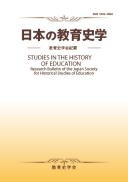49 巻
選択された号の論文の34件中1~34を表示しています
- |<
- <
- 1
- >
- >|
表紙等
-
原稿種別: 表紙
2006 年 49 巻 p. Cover1-
発行日: 2006/10/01
公開日: 2017/06/01
PDF形式でダウンロード (28K) -
原稿種別: 付録等
2006 年 49 巻 p. App1-
発行日: 2006/10/01
公開日: 2017/06/01
PDF形式でダウンロード (8K)
目次
-
原稿種別: 目次
2006 年 49 巻 p. 3-4
発行日: 2006/10/01
公開日: 2017/06/01
PDF形式でダウンロード (77K)
研究論文
-
原稿種別: 付録等
2006 年 49 巻 p. App2-
発行日: 2006/10/01
公開日: 2017/06/01
PDF形式でダウンロード (4K) -
原稿種別: 本文
2006 年 49 巻 p. 6-18
発行日: 2006/10/01
公開日: 2017/06/01
PDF形式でダウンロード (1468K) -
原稿種別: 本文
2006 年 49 巻 p. 19-31
発行日: 2006/10/01
公開日: 2017/06/01
PDF形式でダウンロード (1499K) -
原稿種別: 本文
2006 年 49 巻 p. 32-44
発行日: 2006/10/01
公開日: 2017/06/01
PDF形式でダウンロード (1484K) -
原稿種別: 本文
2006 年 49 巻 p. 45-57
発行日: 2006/10/01
公開日: 2017/06/01
PDF形式でダウンロード (1417K) -
原稿種別: 本文
2006 年 49 巻 p. 58-70
発行日: 2006/10/01
公開日: 2017/06/01
PDF形式でダウンロード (1506K) -
原稿種別: 本文
2006 年 49 巻 p. 71-83
発行日: 2006/10/01
公開日: 2017/06/01
PDF形式でダウンロード (1589K) -
原稿種別: 本文
2006 年 49 巻 p. 84-96
発行日: 2006/10/01
公開日: 2017/06/01
PDF形式でダウンロード (1445K) -
原稿種別: 本文
2006 年 49 巻 p. 97-109
発行日: 2006/10/01
公開日: 2017/06/01
PDF形式でダウンロード (1473K) -
原稿種別: 本文
2006 年 49 巻 p. 110-122
発行日: 2006/10/01
公開日: 2017/06/01
PDF形式でダウンロード (1433K) -
原稿種別: 本文
2006 年 49 巻 p. 123-135
発行日: 2006/10/01
公開日: 2017/06/01
PDF形式でダウンロード (1549K) -
原稿種別: 本文
2006 年 49 巻 p. 136-148
発行日: 2006/10/01
公開日: 2017/06/01
PDF形式でダウンロード (1346K) -
原稿種別: 本文
2006 年 49 巻 p. 149-161
発行日: 2006/10/01
公開日: 2017/06/01
PDF形式でダウンロード (1428K) -
原稿種別: 本文
2006 年 49 巻 p. 162-174
発行日: 2006/10/01
公開日: 2017/06/01
PDF形式でダウンロード (1508K)
教育史学会第49回大会記録
-
原稿種別: 付録等
2006 年 49 巻 p. App3-
発行日: 2006/10/01
公開日: 2017/06/01
PDF形式でダウンロード (7K) -
原稿種別: 付録等
2006 年 49 巻 p. 176-179
発行日: 2006/10/01
公開日: 2017/06/01
PDF形式でダウンロード (224K)
教育史学会第49回大会シンポジウム
-
原稿種別: 本文
2006 年 49 巻 p. 180-
発行日: 2006/10/01
公開日: 2017/06/01
PDF形式でダウンロード (156K) -
原稿種別: 本文
2006 年 49 巻 p. 181-187
発行日: 2006/10/01
公開日: 2017/06/01
PDF形式でダウンロード (756K) -
原稿種別: 本文
2006 年 49 巻 p. 188-192
発行日: 2006/10/01
公開日: 2017/06/01
PDF形式でダウンロード (638K) -
原稿種別: 本文
2006 年 49 巻 p. 193-198
発行日: 2006/10/01
公開日: 2017/06/01
PDF形式でダウンロード (663K) -
原稿種別: 本文
2006 年 49 巻 p. 199-201
発行日: 2006/10/01
公開日: 2017/06/01
PDF形式でダウンロード (347K) -
原稿種別: 本文
2006 年 49 巻 p. 202-206
発行日: 2006/10/01
公開日: 2017/06/01
PDF形式でダウンロード (576K)
研究動向
-
原稿種別: 付録等
2006 年 49 巻 p. App4-
発行日: 2006/10/01
公開日: 2017/06/01
PDF形式でダウンロード (4K) -
原稿種別: 本文
2006 年 49 巻 p. 208-212
発行日: 2006/10/01
公開日: 2017/06/01
PDF形式でダウンロード (613K) -
原稿種別: 本文
2006 年 49 巻 p. 213-226
発行日: 2006/10/01
公開日: 2017/06/01
PDF形式でダウンロード (1778K) -
原稿種別: 本文
2006 年 49 巻 p. 227-234
発行日: 2006/10/01
公開日: 2017/06/01
PDF形式でダウンロード (925K) -
原稿種別: 本文
2006 年 49 巻 p. 235-242
発行日: 2006/10/01
公開日: 2017/06/01
PDF形式でダウンロード (958K)
編集規程・編集後記
-
原稿種別: 付録等
2006 年 49 巻 p. App5-
発行日: 2006/10/01
公開日: 2017/06/01
PDF形式でダウンロード (53K) -
原稿種別: 付録等
2006 年 49 巻 p. App7-
発行日: 2006/10/01
公開日: 2017/06/01
PDF形式でダウンロード (45K) -
原稿種別: 付録等
2006 年 49 巻 p. App8-
発行日: 2006/10/01
公開日: 2017/06/01
PDF形式でダウンロード (48K) -
原稿種別: 表紙
2006 年 49 巻 p. Cover2-
発行日: 2006/10/01
公開日: 2017/06/01
PDF形式でダウンロード (45K)
- |<
- <
- 1
- >
- >|
